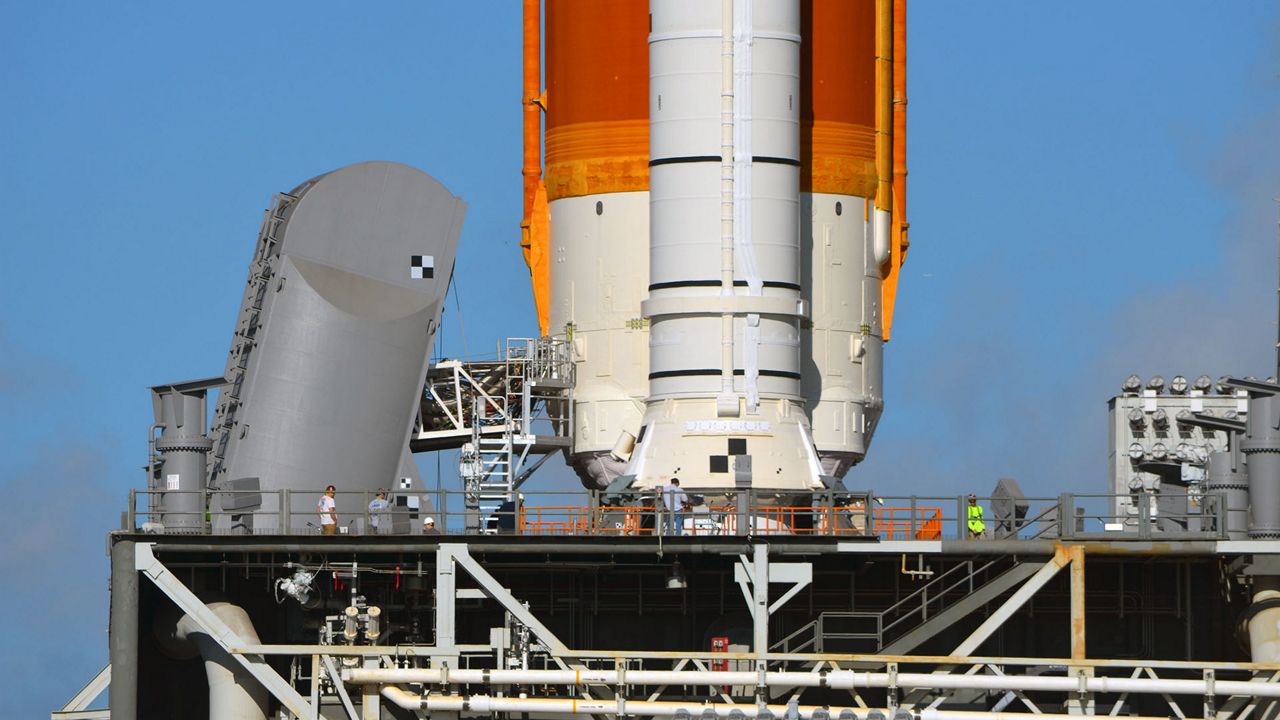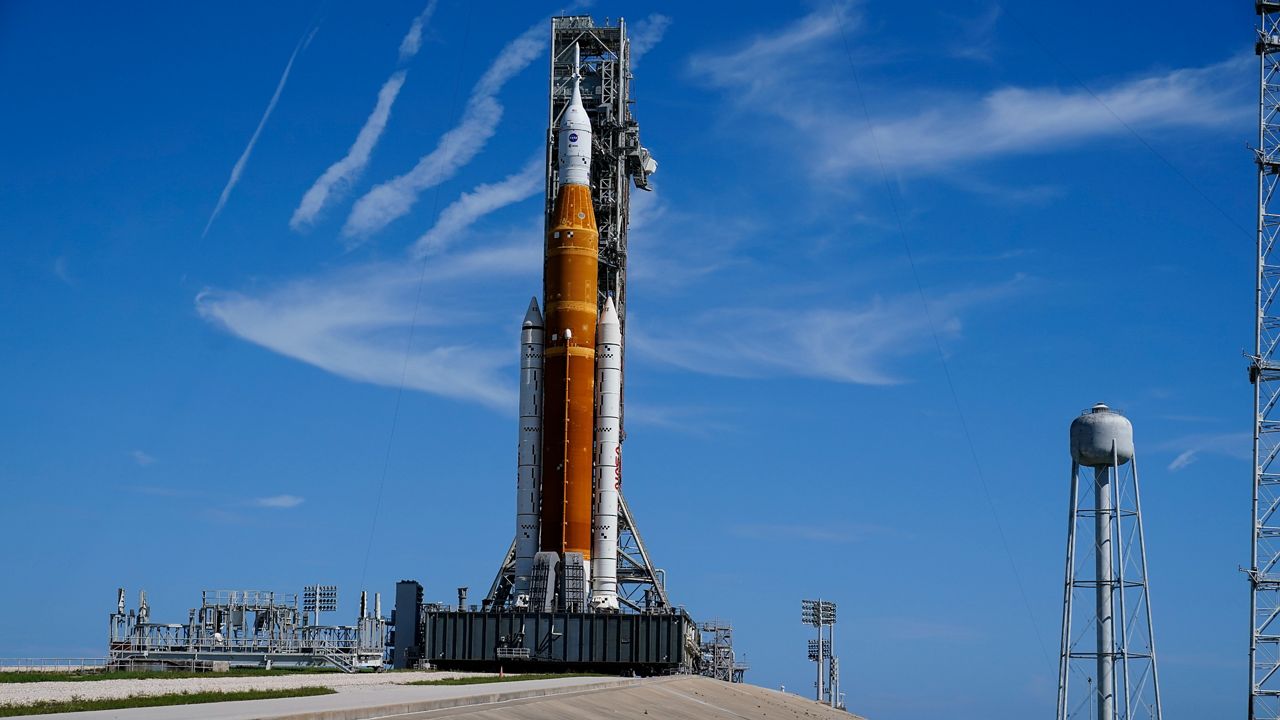KENNEDY SPACE CENTER — NASA has announced two possible launch dates for the Artemis I moon mission after having to scrub the first two attempts due to two different kinds of liquid hydrogen leaks and engine-related issues.
What You Need To Know
- NASA gave two possible launch dates
- Last two attempts were scrubbed due to two different liquid hydrogen leaks in the same area of the rocket
- RELATED coverage:
The space agency is looking at either Friday, Sept. 23, or Tuesday, Sept. 27, to launch the uncrewed Artemis I mission, said Jim Free, associate administrator of Exploration Systems Development Mission Directorate, during a teleconference on Thursday.
The Sept. 23 liftoff will have a 120-minute launch window that opens at 6:47 a.m. EDT, while the Sept. 27’s has a 70-minute window that opens at 11:37 a.m. EDT.
However, he pointed out that it depends on the Eastern Range, which starts at the launch pads at Cape Canaveral Space Force Station and Kennedy Space Center and extends eastward over the Atlantic Ocean and into the Indian Ocean.
NASA has submitted a waiver package to the Eastern Range for approval, asking for the waiver to not roll the Artemis I’s Space Launch System rocket and the Orion capsule back into the Vehicle Assembly Building to recharge the batteries of the flight termination system that are located on the core stage of the rocket, described Space Launch System rocket chief engineer John Blevins.
“Having said that, we're trying to plan a path forward if we're allowed to extend our battery retest requirements on the flight termination system,” he said, which determined the two tentative launch dates.
There are a total of three batteries and one is for each command receiver decoder, explained Blevins, who said the flight termination system is designed for public safety. He says that all systems, including the batteries, are being monitored while on the launch pad.
In addition, Blevins stated that rollbacks of the Artemis I can cause a lot of wear-and-tear to it and the systems, something that NASA wants to avoid unless it is necessary, he said.
The other purpose of the teleconference was to provide an update on the repairs of the liquid hydrogen leak as the rocket and the Orion spacecraft are currently sitting at Launch Pad 39B at the Kennedy Space Center.
Problems getting off the ground
The second attempt on Sept. 3, was scrubbed after a liquid hydrogen leak near the bottom of Artemis I’s Space Launch System rocket. The area has an 8-inch quick disconnect line that is an umbilical that is used to feed the liquid hydrogen from storage tanks into the rocket’s core stage.
In Thursday’s teleconference, Mike Bolger, Exploration Ground Systems program manager, said NASA’s team of engineers is planning to replace the seals and determine what caused the leak, but cautioned that the repair may not solve the issue.
“We are not 100% certain this will resolve the issues,” Bolger said of the leaks, but he feels confident about it.
Later on Thursday, NASA confirmed what Bolger said the team would do: That the team disconnected the ground and rocket-side plates on the quick disconnect for the fuel line for the liquid hydrogen and replaced two seals: “one surrounding the 8-inch line used to fill and drain liquid hydrogen from the core stage, and another surrounding the 4-inch bleed line used to redirect some of the propellant during tanking operations.”
An enclosed area has been set up around the work zone to not just protect the equipment from the weather but the team also wants to test the repair under super cold conditions.
“Performing the work at the pad also allows teams to gather as much data as possible to understand the cause of the issue,” NASA explained on Tuesday.
And weather is not an issue, said Bolger, who said that the lightning protection towers around Launch Pad 39B can allow engineers to work even during a phase two lightning storm. In fact, lightning struck the two of the three towers three times in August.
While we were waiting for the @NASA #Artemis1 launch earlier today, Mark Burger of the #45thWeatherSquadron spoke to me about lightning strikes and protection towers. (See what happened on Saturday at #Artemis’ #LaunchPad39B.)https://t.co/K9EVrIgDHQ pic.twitter.com/XqyzowMgmq
— Anthony Leone (@AnthonyLeone) August 29, 2022
On Thursday’s teleconference, Bolger did say that during Saturday’s second launch attempt, engineers did not overstep the hardware’s design specifications when fueling, but admitted that it is still unclear if that was the reason behind the liquid hydrogen leak.
Bolger said the teams have only gotten a cursory look at the sea of the 8-inch quick disconnect and noticed a minor notch on it but a more thorough investigation will be done.
If the seals are replaced by Thursday, NASA will conduct re-tests to make sure all the systems are working as expected on Friday and it is targeting Saturday, Sept. 17, for a cryogenic test to determine if the seals are good, Bolger said, which he remarked would be a “gentler approach to tanking”.
This supercold test will include loading the core stage and interim cryogenic propulsion stage with liquid oxygen and liquid hydrogen.
When asked why there is not another full-wet dress rehearsal of Artemis I, Bolger said the previous rehearsals have already captured what needed to be done and more are not needed.
Free described how the hardships of dealing with liquid hydrogen and that leaks were common during the space shuttle era. But he pointed out that this is the first time operating the Artemis rocket and leaks can be expected, even adding that commercial vehicles have had challenges during their first launches.

Past launch attempts that were scrubbed
Following the second launch attempt, NASA administrator Bill Nelson said that scrubs were common in NASA’s history and Artemis I has been no different.
The first attempt was on Monday, Aug. 29. It was called off after NASA teams were unable to chill down the rocket’s four RS-25 engines to about minus 420 degrees Fahrenheit. Engine 3 was showing higher temperature readings than the other engines.
The engines need to be thermally conditioned before they can receive the subzero fuel as the Space Launch System rocket needs 730,000 gallons of super-cooled liquid hydrogen and liquid oxygen for liftoff.
Speaking of liquid hydrogen, a leak was discovered at the tail service mast umbilical quick disconnect, called the purge can.
During a Sept. 3 press conference after the scrubbed-launch attempt, Artemis Mission Manager Mike Sarafin said that the liquid hydrogen leak was different from the first attempt.
During that same press conference, Free explained it as:
“The confidence to do another launch attempt was born out of the fact that we understood the hydrogen leaks that we had on Monday — those are different than the leak that we had today,” he said during the Saturday press conference. “In terms of scale, one was in the same place, but was a different signature.”



